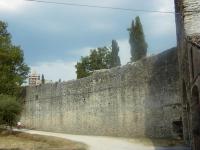Bevagna -
Medieval Town walls and Church Saint Francis
 |
The medieval Town walls which still surround the whole town have been built between 1249 and 1377, partly on top of the Roman which show the stratifications of the various construction periods from the 3rd century B.C. until the 1st century. The fragments of stone pavement found in the central Corso Matteotti just behind the gate prove that the original Via Flaminia was identical to the actual main street crossing the whole town.
Turning to your right after the gate, in Via S. Francesco you will follow the curved front of a row of houses which traces the plan of the Roman Theatre of the 1st century. On the back of these houses two semicircular corridors now are used as cellars and garages, while the remains of the stage lie underneath the actual Post Office.
In front of the theatre rises the Chiesa di S. Francesco on the highest peak of the town, dating back to 1275, with its contigous convent attached to the town walls. The unfinished front with its elegant polystyle portal is the original one, while the interior which has been transformed in Baroque forms in 1746-50 conserves in the Cappella del Sacramento a fresco by Ascensidonio Spacca, called Fantino di Bevagna, of 1594 and 'Crucified with angels' and 'S. Francesco' by Dono Doni. There is as well the stone on which S. Francis stood during his sermon to the birds at Pian d’Arca. The dome with majolica decoration by Santi Buglioni is also remarkable.
© Copyright 2001-2025
by Umbriaonline.com
SCG Business Consulting S.a.s. di Giacomelli E. & C. - Internet Advertising Division - © 2001-2025 All Rights Reserved - P.IVA 01675690562